by Caitlin Franzmann and Amaara Raheem
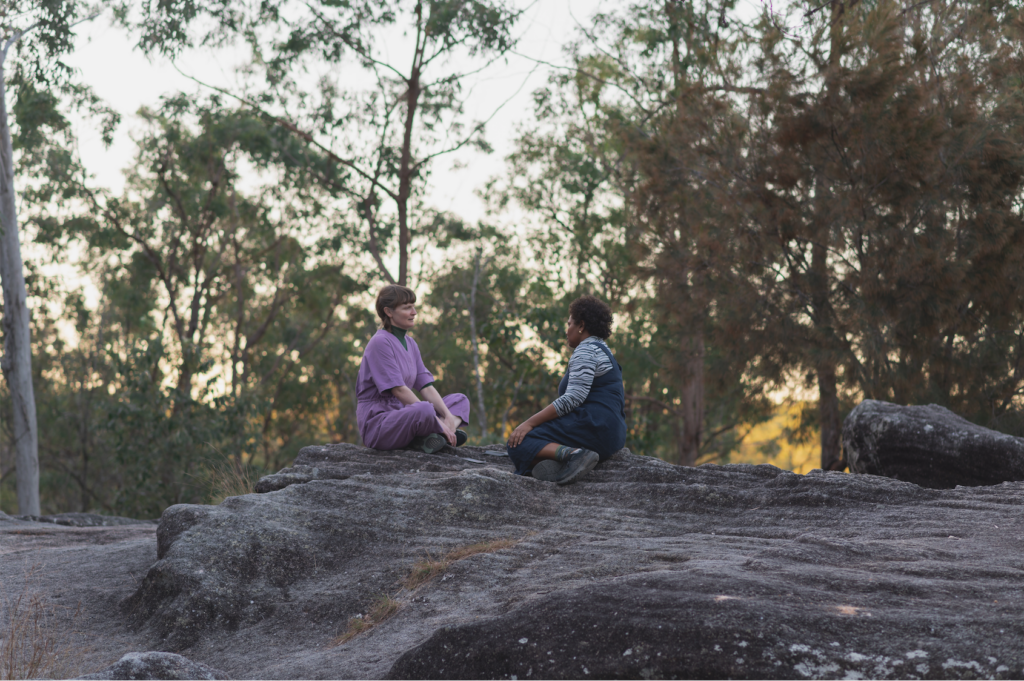
Photo by Keelan O’Hehir, 2022
Caitlin and Amaara sit on the quartz sandstone ridges of Karawatha Forest surrounded by Eucalypts. Sinking into geological time, the folding rocks and plant fossils enfold their skin, their senses. The rocks tell of ancient floods and volcanic eruptions. Stories of connection to Country exist both in the landscape and as knowledge and practices still shared by the Yuggera and Jagera people.
With deep respect and an open heart, ‘Fortunes of the Forest’ is an ongoing process of learning with these traditional custodians alongside local conservationists, scientists and the forest. Caitlin holds a set of divination cards she created in collaboration with photographer Man Cheung.
Each card depicts an image of a plant, rock or insect found
in the forest, offering plant knowledge and guidance. The forest bodies communicate with their bodies, entangled in co-breathing and living processes. Opening up to the energies of their surroundings they ask the cards, how can we grow – and share – our collaboration like a forest?
Caitlin shuffles the deck quickly and in this way, a card or two jumps out. They discuss how each entity survives and evolves, and share stories of their encounters. Reflecting on their collective question, a text bursts forth.
Card 1: subtle messages
Eucalyptus racemosa // scribbly gum
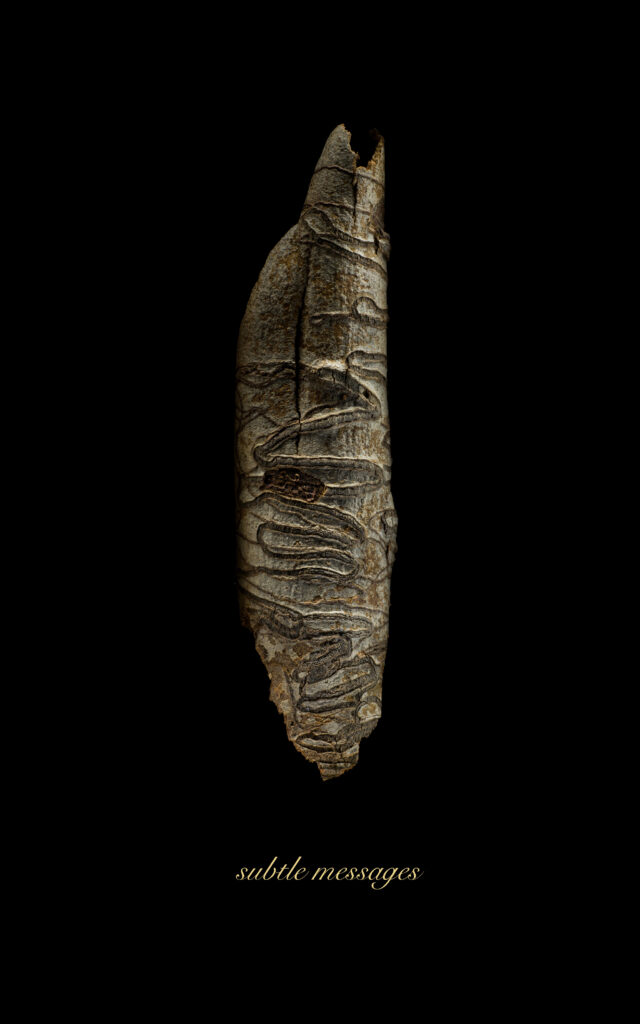
Text 1:
Graeme Miller, Moth Theatre (2010) commissioned
for the Latitude Festival, Suffolk, UK.
Amaara first met Graeme Miller at a party. Graeme is an artist, theatre maker and composer based in London. In 2010 Graeme built a small-scale freestanding plywood theatre fitted with a video feedback system and ultra-violet lighting. He called it a ‘theatre for moths by moths’. Insects are drawn to the miniature cinema where their image is filmed and fed back to the same screen generating pattern and unwitting choreography. Amaara never saw this work, she only heard about it at a party. But she’s thought about it often and now here it is, again.
Eavesdropping on this evolving and autonomous performance ‘Subtle Messages’ guides us to stand in a pool of our own radiance.
Card 2: nesting
Drynaria rigidula // basket fern
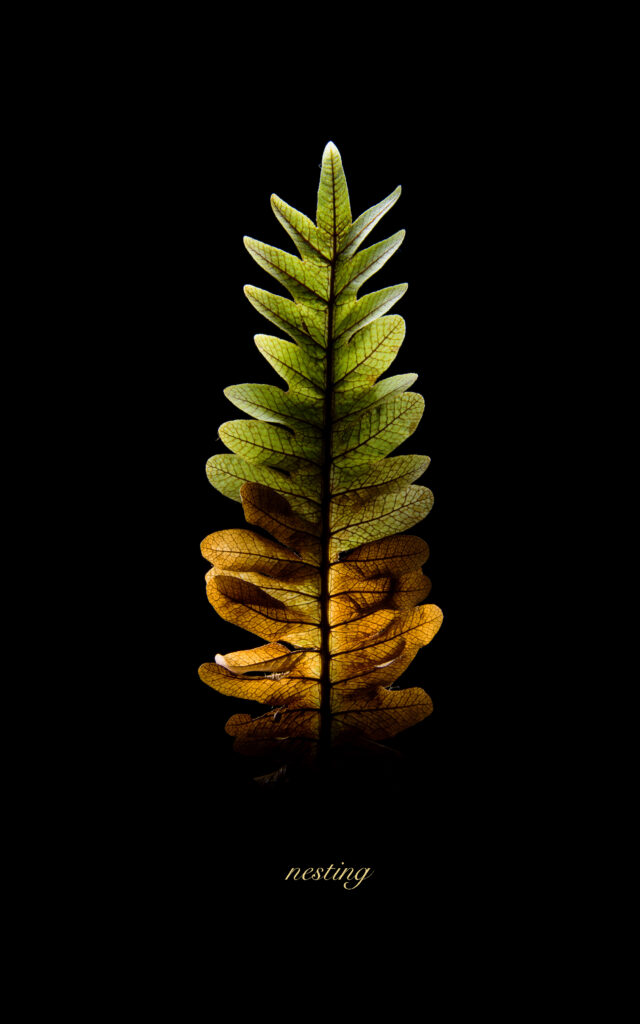
Text 2:
adrienne maree brown, Emergent Strategy: Shaping Change, Changing Worlds, USA: A K Pr Distribution, 2017.
Amaara and Caitlin are driving to Karawatha Forest. In- residence in Karawatha they’re developing a new iteration of ‘Fortunes of the Forest’ for ‘Embodied Knowledge’ exhibition at QAGOMA, 2022. On the way there and on the way back, they listen to the audio-book Emergent Strategy written and read by adrienne maree brown. brown’s voice is so melodic and lyrical. It’s as if ‘radical self-help, society-help and planet- help strategies’ spoken/sung by brown magically manifest new futures in the here-and-now. Caitlin and Amaara are swirling in a stream of ever-mutating, emergent patterns as they navigate Brisbane traffic-time in order to sink into Karawatha Forest-time. In the forest they lie on the warm rocks and take time to breathe in and out with the clouds. The basket fern is a resting, nesting place for snakes.
Nesting, as an emergent strategy, invites us to learn from the swirling patterns around us in order to better understand and influence them as they happen.
Card 3: changing form
Meta-mudstone
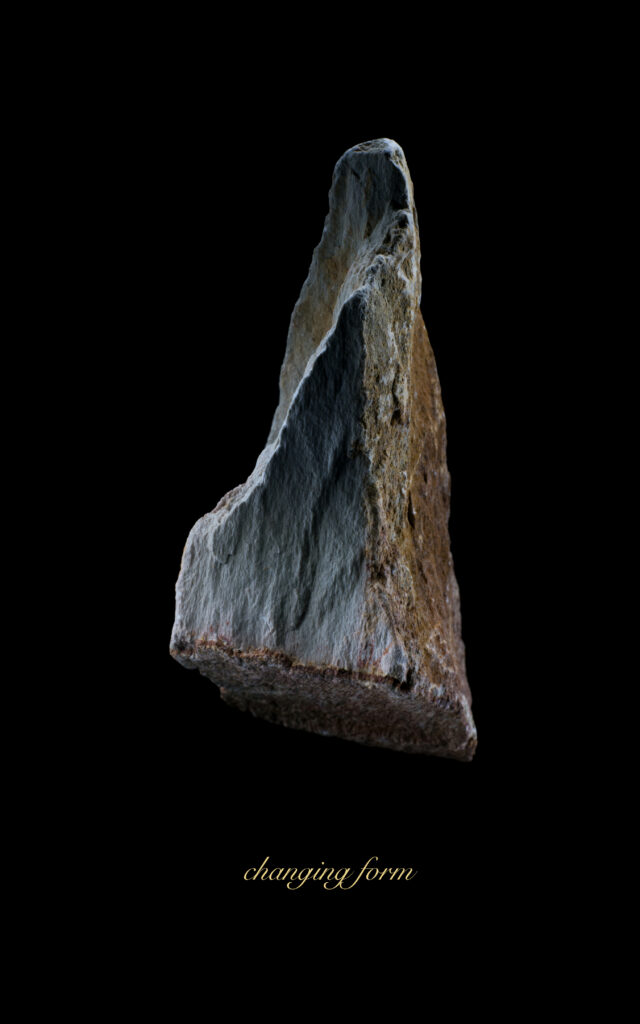
Text 3:
Ecological Gyre Theory, a performance-lecture by Chantelle Mitchell and Jaxon Waterhouse (2021). ‘Writing-Concepts’ in collaboration with the Australian Centre for Contemporary Art.
In 2020, Amaara participated in an online curriculum ‘Abyss Lessons’ facilitated by Chantelle Mitchell and Jaxon Waterhouse of Ecological Gyre Theory (EGT) in partnership with Bus Projects. In this course Amaara first encountered the term ‘vortextual thinking’ and what EGT calls, ‘our human and other-than-human entanglements through depth as a measure of being’. Over five sessions, this program engaged with the abyssal spaces and entanglements of extractivism and ecology. It was a fascinating, terrifying, demanding and disturbing submersion into the slow, continual violence of mining. Subsequently EGT gave this compelling performance-lecture which outlines their ongoing attempts to reframe possibilities of knowing and being within a vortextual frame.
Found in the quarry of Karawatha Forest the meta- mudstone invites us to step into the depths and be beholden to the abyss.
Card 4: essential decay
Pycnoporus coccineus // scarlet bracket
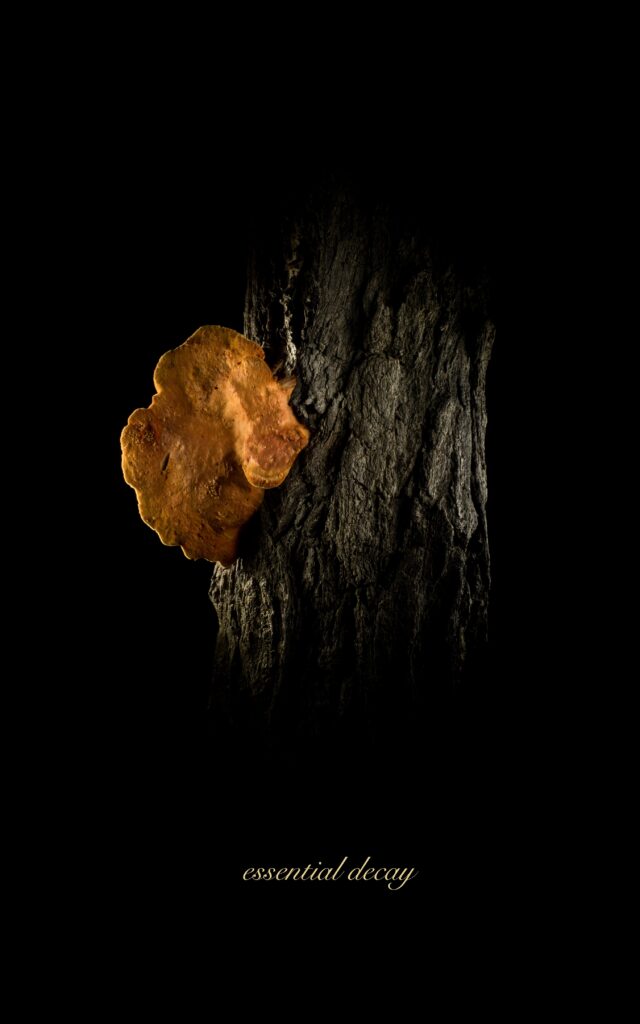
Text 4:
Giuliana Furci and Sophie Strand (2022). The Inner World of Fungi: Expeditions, Advocacy and Poetics (Episode 3 of ‘Life Worlds’) a podcast hosted by Alexa Firmenich.
In 2018, Caitlin met Giuliana Furci at a dinner in Santiago. Giuliana is Chile’s first female mycologist and founder of
Fungi Foundation. They talked about the need to let things rot. Fungi is more than a fruiting body. It’s a complex network of mycelium and interactions occurring under the surface. This podcast explores the lives of women that are deep in relationship with fungi and related ecologies. Together, they reference other philosophers, activists and multi-species kin that have influenced their own thinking. Caitlin loves following their threads of inquiry through which she becomes aware of the microbial colonies transforming her own body.
Essential decay advises us to accept death and, from the rot, ask how to live.
Card 5: spirited force
Eucalyptus tereticornis // Queensland blue gum
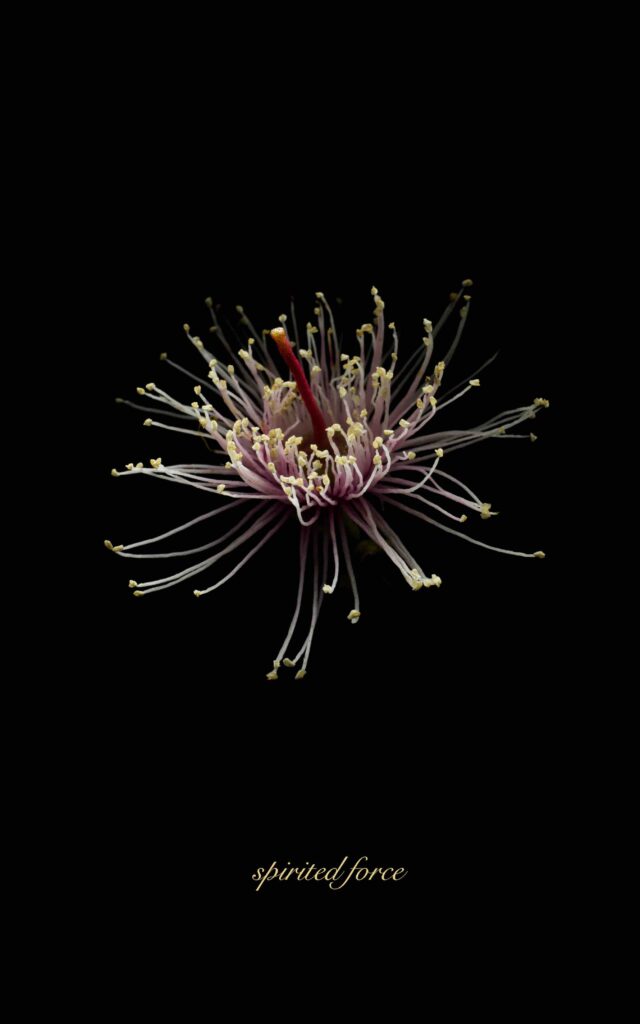
Text 5:
C.F. Black, ‘A Mosaic of Indigenous Legal Thought: Legendary Tales and Other Writings’, Routledge, 2017.
In 2017, Caitlin was in residency at Karawatha Forest. She often pondered if it was ok to take things from the forest for art. ‘How do we seek permission from the plants?’ she asked the wind.
A blue gum branch fell at her feet. ‘What did you feel in the forest’s reply?’ Dr. C.F. Black (Christine) later asked. Christine, a Kombumerri/ Munaljahlai woman and legal scholar, understands how to interact with both plant beings and other beings on Earth in a lawful manner. Stories come to Christine. She studies patterns – microbial, political, planetary, cosmic – and acknowledges animals, plants and fungi as natural mediators to teach humans how to act lawfully.
Spirited force invites us to pay attention to the rhythmical order of the forest and share the tales that push forth.
Card 6: release
Boronia rosmarinifolia // forest boronia
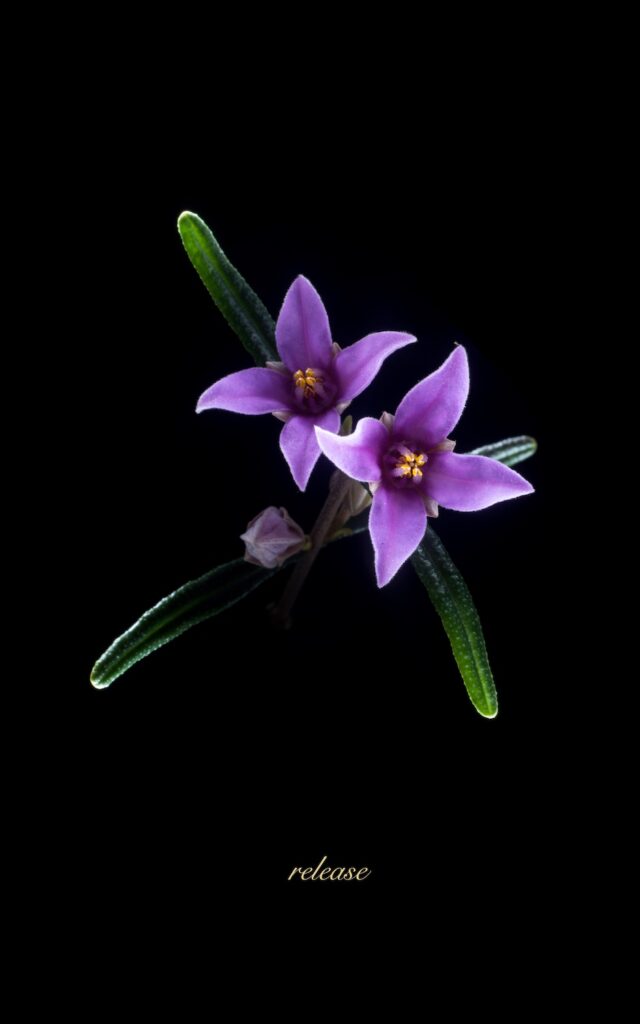
Text 6:
Boronia Bush Flower Essence,
Australian Bush Flower Essences.
In 2017, Caitlin began using Australian Bush Flower Essences as medicine whilst on residency in Karawatha Forest. Swamp banksia for energy, waratah for courage and bluebell for trust. The pink flush of boronia flowers across the forest understory sparked her curiosity into the making of plant essences – the sensitivity, the reverence, the ritual. Over time, she witnessed the starry bloom close over the ripened fruit. She learnt that the capsule eventually explodes and scatters its seeds in the summer heat. She understood the plant vibrates ‘release’.
Forest boronia prescribes its essence: 7 drops under the tongue, morning and night. We let go of expectations and trust that clarity and focus will come in what surfaces from the mud.
Card 7: vital breath
Allocasuarina littoralis // black sheoak
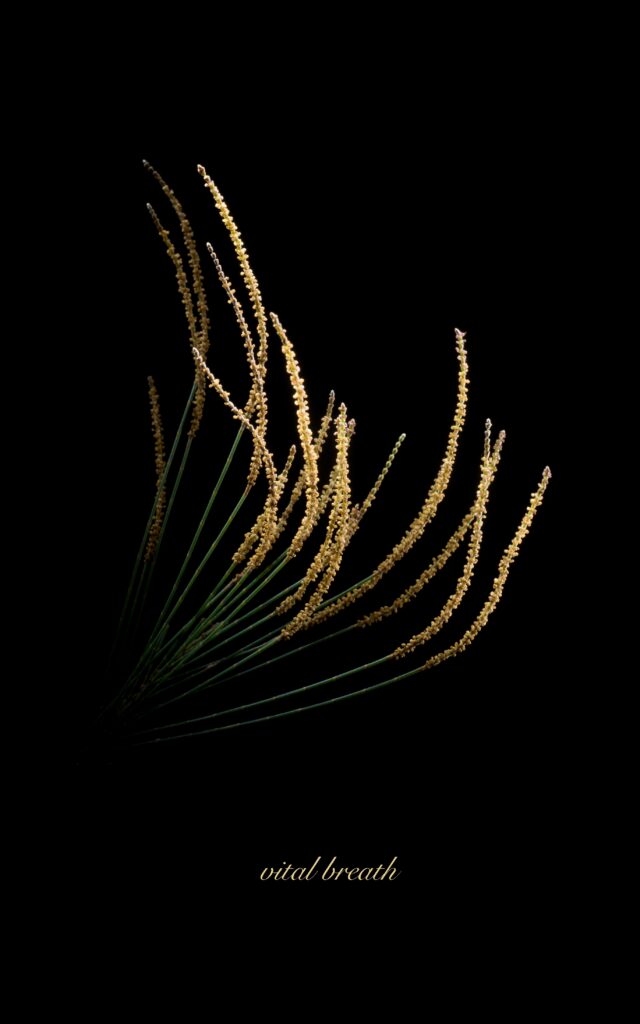
Text 7:
Miranda Tuffnell and Chris Crickmay, Body, Space and Image: Notes towards improvisation and performance,
Dance Books Ltd., 1990.
In 2004, Amaara made a long train journey to Abercych, west Wales, to a dance studio nestled in the magical Gwyddil Valley for a week long retreat with dance artist, writer and teacher in movement and imagination, Miranda Tuffnell. Here Amaara, along with other dancers, explored body and landscape amidst the glory of bluebells up near the beginning of the track across the river; slid over fallen trees; opened her senses; sat in the sun; sourced natural clay, kits, arrangements, scale, materials, light and sound in the woodlands, riverbed and pasture; collected wild garlic; let the sensation of thought dissolve through her body allowing their own time and expression; watched wild ducks make their way upstream; unfastened a space between thoughts; cultivated a sense of openness, an availability for movement.
‘Vital Breath’ calls us to soften, deepen, wait, observe, listen and rest; to connect our whole selves to performance.
Card 8: climber
Macfadyena unguis-cati // cat’s claw creeper
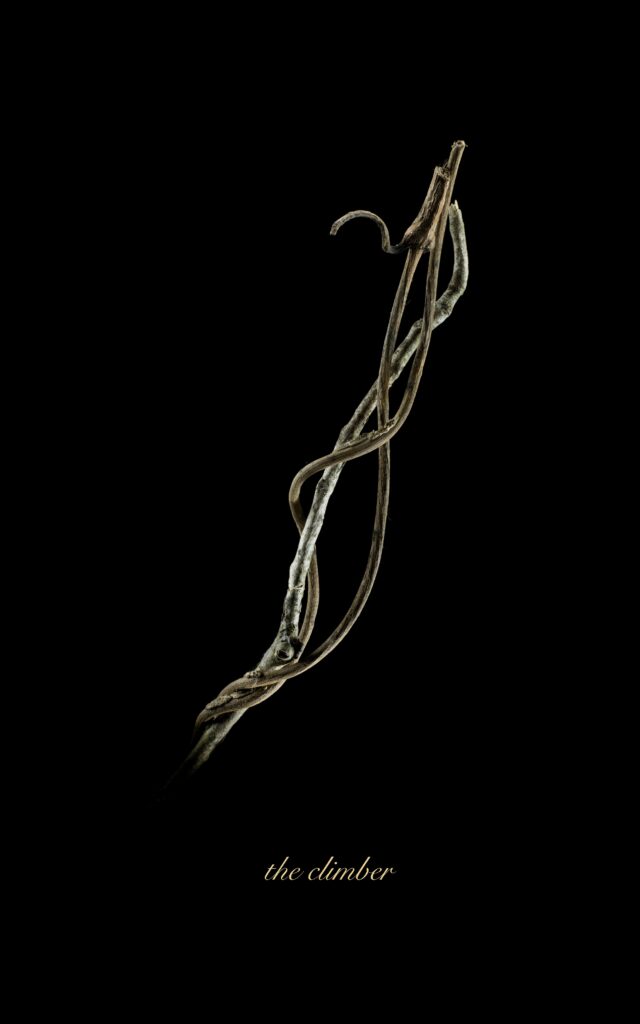
Text 8:
Kate Wall, Working with Weeds:
A practical guide to understanding, managing and using weeds, Katerina Wall, 2019.
In 2020, Caitlin planted a garden of ‘weeds’ at Institute of Modern Art, Brisbane, under the guidance of weed expert Kate Wall. It was a garden of food and medicine plants that would thrive with little care and attract pollinators to the concrete context. Kate doesn’t judge a plant as good or bad until she takes time to understand it. She reads the conditions of the ecosystem in which it grows, asking ‘what are the plants telling us – about the soil, about climate, about history?’ Through observation and systems thinking, Kate can identify when a plant is a problem and establish holistic methods of control that will ‘do no harm’.
The climber invites us to be discerning in our choices; to perceive things as they are in place and time.
Card 9: fertile ground
Gompholobium latifolium // golden glory pea
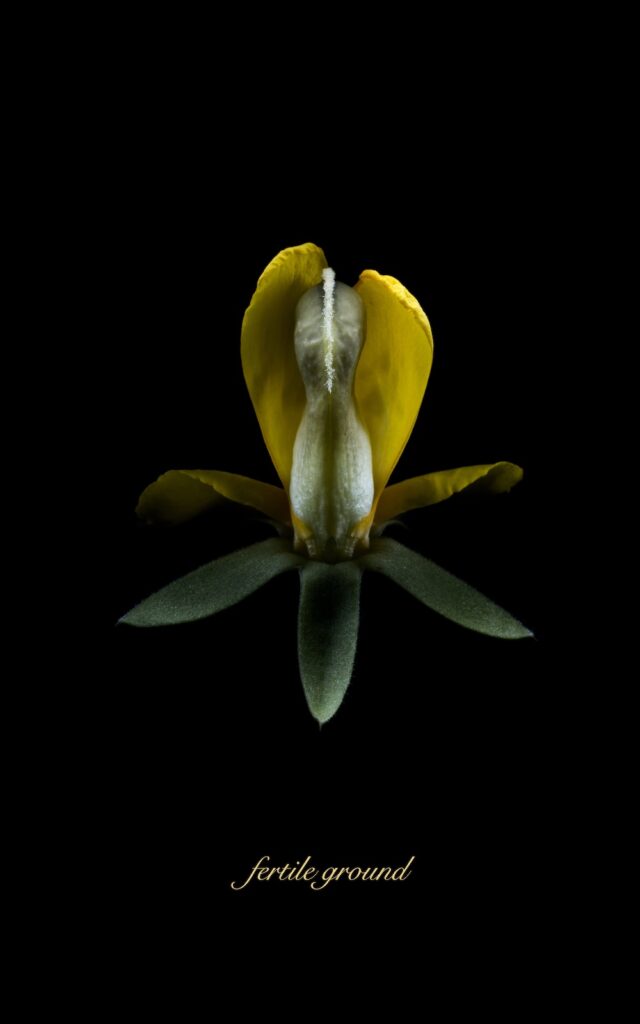
Text 9:
Gloria Anzaldúa, Light in the Dark/Luz en lo Oscuro: Rewriting Identity, Spirituality, Reality, Duke University Press, 2015.
In 2018, Caitlin participated in a residency with research collective Ensayos. She sat by a fire with a group of women (Ensayistas), in a cabin, at the southernmost tip of Tierra del Fuego, Chile. Camila Marambio and Sarita Galvez took turns reading Gloria Anzaldúa out aloud. It was as though she was in the room encouraging us to consciously inhabit our bodies. Our tears became green saplings pushing through the cracks in our foundations. Andalzua tells us our imaginations and dreams are embodied knowledge that, with awareness and care, can affect personal and societal change.
Fertile ground invites our full, fleshy bodies to participate in the world; to sprout wings from our wounds.
Caitlin Franzmann is a Meanjin/Brisbane based artist who creates installations, sonic experiences, performances, and social practice works focused on place-based knowledge and embodied practices. She originally trained as an urban planner, working for several years in policy and strategic planning roles. Since completing a Bachelor of Fine Art at Queensland College of Art in 2012, she has presented work nationally and internationally, including at Kyoto Art Centre and New Museum (NYC). She was recipient of the 2014 Churchie National Emerging Art Prize and was selected to exhibit in TarraWarra Biennale 2021. As a member of the feminist art collective LEVEL (2013-2018), Caitlin presented participatory works and co- curated exhibitions and forums with a focus on generating dialogue around gender, feminism and contemporary art. Since 2010 she has been working with Ensayos, a collective research practice focused on eco- political issues impacting Tierra del Fuego and other archipelagos.
Amaara Raheem (b. Colombo, Sri Lanka) is a dance-artist, researcher, writer and curator working with movement and language. Her work is site-specific, multi-modal and includes live performance, video, text, voice and improvisation. She’s often involved in collaborative processes of performance making, underpinned by a strong feminist sensibility. She holds a PhD by practice from the School of Architecture and Urban Design (RMIT University) and was recently selected for the ABC Top 5 media residency. Amaara co-curates Now Pieces – a platform for improvised performance – at Dancehouse and sits on the Artistic Directorate of Next Wave.
